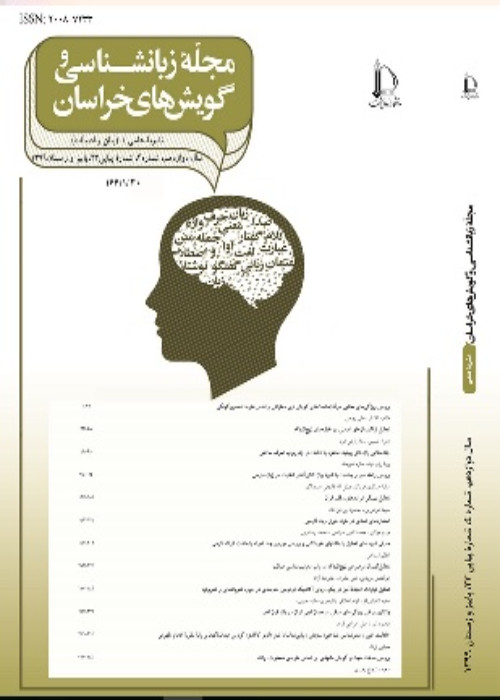A Cross-Linguistic Analysis of Impersonal Constructions
Author(s):
Abstract:
Introduction
The diversity of impersonal constructions and the different approaches used in studying them have caused different and sometimes contradictory positions about their classification and the explanation of grammatical and semantic roles of their components. This article reveals the necessity of studying them with a new approach which pursues a common basis covering all the possible sorts of impersonal constructions. In the present research the traditional approaches toward studying these constructions, i.e., functional and structural ones, have been conflated and have made a new method in handling the issue. This research deals with the constructions from a perspective that emphasizes subject and its properties. In doing so, first, based on Malchukov and Ogawa (2011), a series of features which is regarded as functional properties of subject prototype is selected (definiteness, topicality, agentivity, referentiality) from Keenan's (1976) viewpoint. Following the idea that any reduction in functional features is reflected in formal appearance of sentences and leads them toward impersonality, the research probes data from different languages and presents a new categorization of impersonal constructions in Persian cross-linguistically.Methodology
The present qualitative research has been carried out to unify different analyses of impersonal constructions in Persian and to give comprehensive accounts. Following Malchukov and Ogawa (2011), we have conflated communicative-functional and structural approaches. The data were collected from different books. Since we are native speakers of Persian language, we relied on our introspective judgments about the well-formedness of these extracted constructions.Discussion
The term impersonal is ambiguous and controversial. From the functional perspective, impersonalization is defined in terms of agent defocusing, and from the structural view, impersonality is related to the lack of subject (or the lack of grammatical features of subject such as inflection of verb) (Malchukov & Siewierska, 2011, p. 2). Current studies of impersonal constructions in Persian are complex, heterogeneous and to some extent not comprehensive. On one hand, traditional classifications confine impersonality to the lack of agreement between subject and verb. On the other hand, the diversity of these classifications poses some complexity. To handle the diversity and to take the first step towards a comprehensive analysis of impersonal constructions in Persian, we pursue new view of impersonality and we follow the methodological point proposing that the study of impersonals should focus on both structural and functional perspectives.The main question of this research is how we can associate functional and formal varieties of impersonal constructions. The hypothesis we adopt is that deviation from functional features of a prototypical subject is reflected in the formal structure of the sentence. In fact, following Givon (2005) and Malchukov and Ogawa(2011), we take Keenans definition of the basic subject and from his 30 linguistic properties including functional, semantic, coding, structural and behavioral properties, we focus on a few functional features applicable cross-linguistically (i.e., definiteness, topicality, agentivity, and referentiality) and study their relation with formal (coding) features in Persian impersonal constructions.
This paper is structured as follows: in section 2, we discuss contradictory views of different linguists about impersonal constructions in Persian. In section 3, we study two different functional and structural approaches to impersonal constructions. In section 4, taking both these approaches, we discuss cross-linguistic variation of impersonal constructions and overview its availability in Persian. Finally, section 5 summarizes the results of this article and gives a new classification from impersonal constructions in Persian.
Conclusions
In summary, regarding the relation between functional properties (a decrease in functional properties contributing to subject hood: agentivity, definiteness, etc.), and formal properties of impersonal constructions cross-linguistically, we can propose the new classification of impersonal constructions in Persian as follows: 1- Impersonal constructions with non-referential subjects or weather constructionsa. (Dummy) subjects of weather verbs (bad juri mibare) (It's raining cats and dogs.)
b. Dummy verb construction (aftab zade ast) (The sun has risen.)
c. Cognate construction (baran mibare) (It rains.)
d. Weather constructions with a semi-formal subject (i.e., lexical subject with a nominal meaning world, weather or sky or mythological subjects(khoda barane rahmatash ra bar ma mibarad)(Gods mercy is rained on us.)
2- Impersonal constructions with indefinite subjects
a. Use of zero pronouns through inflection of verbs (migan inja hame tahsil karde hastand) (they say all the people are educated here.)
b. Use of impersonal pronouns (ma montazerim yeki in moshkel ra hal kone) (We look forwardto somebody solving this problem.)
c. Use of special lexical subjects: man- impersonals (adam bavar nemikone) (no one believes it.)
d. Auxiliary impersonals(bayad gozasht va raft)(We must leave everything behind and go away)
3- Impersonal constructions with non-topical subjects
a. Expressive sentences (malum ast ke anha inja budeand) (It is clear that they have been here.)
4- Impersonal constructions with inanimate subjects (agents)
a. Absence of agreement (in languages in which agreement is controlled by animatearguments(namehayi ke be etmam reside bud ersal shod)(The letters which had been finished were sent.)
5- Impersonal constructions with non-volitional subjects (agents) Experiencer-anticausative constructions or inaccusative languages (delam gereft, Ali bimar shod) (I feel down, Ali became sick.)
Keywords:
Language:
Persian
Published:
Journal of Linguistics & Khorasan Dialects, Volume:8 Issue: 14, 2016
Pages:
77 to 109
magiran.com/p1627224
دانلود و مطالعه متن این مقاله با یکی از روشهای زیر امکان پذیر است:
اشتراک شخصی
با عضویت و پرداخت آنلاین حق اشتراک یکساله به مبلغ 1,390,000ريال میتوانید 70 عنوان مطلب دانلود کنید!
اشتراک سازمانی
به کتابخانه دانشگاه یا محل کار خود پیشنهاد کنید تا اشتراک سازمانی این پایگاه را برای دسترسی نامحدود همه کاربران به متن مطالب تهیه نمایند!
توجه!
- حق عضویت دریافتی صرف حمایت از نشریات عضو و نگهداری، تکمیل و توسعه مگیران میشود.
- پرداخت حق اشتراک و دانلود مقالات اجازه بازنشر آن در سایر رسانههای چاپی و دیجیتال را به کاربر نمیدهد.
In order to view content subscription is required
Personal subscription
Subscribe magiran.com for 70 € euros via PayPal and download 70 articles during a year.
Organization subscription
Please contact us to subscribe your university or library for unlimited access!


